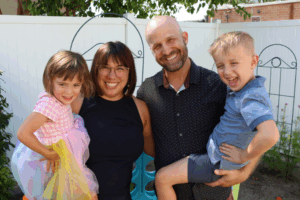Sleep—the one thing new parents are always deprived of themselves. But what about our little ones? How can we keep them safe and ensure they are getting enough sleep in the optimal environment? It starts when you bring your baby home.
What to Expect After Bringing Your Baby Home
Newborns sleep a significant amount when they are first born. I often joke that babies eat, sleep, pee and poop with new parents who are worried about how much their newborn is snoozing. And, I assure them this will change. Newborns sleep 16-18 hours a day, and then from ages 4-12 months, most babies need only 12-16 hours of sleep a day, including naps. That will leave plenty of time for all those other first milestones.
Creating the Optimal Sleep Environment for Your Baby
Where should babies be while they are sleeping? There are some key points all parents should follow.
Babies need to sleep alone, in their own space and on a firm mattress on their backs.
Many parents want to co-sleep with the baby in their bed. But, most beds adults sleep on are too soft, with too many extras like pillows and blankets that are suffocation risks for our little ones. It is recommended that babies sleep in their own crib, bassinet or portable pack ‘n play. The mattress should be firm and flat, and a fitted sheet may be used on top to keep it clean. If you are concerned about your baby being alone, it is okay to place their crib, bassinet or pack ‘n play right next to your bed so you can reach out and touch your baby.
I recommend parents always check the product they are using (crib, bassinet, etc.) with the Consumer Product Safety Commission to ensure it meets safety standards. This is especially important if buying second-hand items. The American Academy of Pediatrics (AAP) recommends babies sleep in their parents’ room for the first six months before moving to their own room.
Although babies often fall asleep in car seats, swings and bouncers, expert recommend moving them to their crib once asleep. Additionally, newborns are often held while sleeping. This is great and totally fine if the person holding the baby is awake, but if they begin to feel drowsy, they should lay the baby down to avoid an accident.
Babies who sleep on their backs are much less likely to die suddenly in their sleep versus babies who sleep on their tummies. I always tell parents to make sure the baby’s pelvis is flat when they lay them down. Babies who are laid on their sides can more easily roll to their tummies by accident, increasing their risk of Sudden Infant Death Syndrome (SIDS). Flat on the back is safest! Once babies learn to roll themselves from back to front and front to back, it is safe to allow them to roll during sleep. Even so, it is best to start them on their backs.
A few more tips…
- Babies should never have pillows, stuffed animals, crib bumpers or blankets in bed with them, as these items increase their risk of suffocation.
- Newborns often like to be swaddled. Typically, we should stop swaddling babies by 2-3 months and switch to using a sleep sack with their arms out for safe sleep.
- Avoid weighted sleep sacks as the extra weight on your baby could mimic the same scenario as a baby sleeping on their tummies, resulting in crib death.
- We never want babies to be too cold or too hot. I recommend keeping the thermostat between 68-72 degrees year-round to keep infants comfortable. You can always adjust the number of layers the baby is wearing to help regulate their temperature.
- We do not recommend wearing a hat inside since the head is often how babies thermoregulate and they can easily get too warm.
How to Help Your Baby Know Day from Night
After birth, babies often have their days and nights mixed up. They do not have regular sleep cycles until around four months of age. There are a few tricks you can try to help your baby (and you) get a better night’s sleep.
At night when you want your baby to sleep, avoid overstimulation:
- Always be as quiet as possible, speaking in soft, quiet tones and keeping other noise low
- Keep the lights dim with only enough light for you to safely see your baby for things like diaper changes.
- This will teach your baby that night is when we sleep.
Conversely, during the day, we want to be awake and play! To encourage this:
- Have the lights on
- Speak at normal volumes
- Do things like vacuum and make noise
- This will teach your baby that day is when we play, read books, sing songs and talk.
When to Begin Teaching Your Baby to Fall Asleep on Their Own
Starting at about four months of age, I suggest trying to have babies learn to fall asleep on their own. Prior to four months, we are used to putting them down when they fall asleep eating or being held. However, normal sleep/wake cycles have us all waking up several times throughout the night. If we wake up in a different scenario than where we fell asleep, it is startling. Teaching them to fall asleep on their own allows them to be able to fall back to sleep without needing to be held or fed by a parent.
Often parents will feed babies when they wake up at night to help them go back to sleep. This will cause your baby to become more of a trained nighttime eater. As babies get older, they should be able to sleep through the night without eating. Especially when they have teeth, feeding at night increases their risk of cavities.
Sleep Training
Deciding when to sleep train your infant is a hard decision. Often parents worry they are harming their child by letting them cry and not attending to them right away. Many infants, if allowed to cry for a few minutes at night, will fall right back to sleep on their own.
There are many different techniques for sleep training and all of them are equally effective. I suggest parents research the various techniques to determine which one is most comfortable for you. The key takeaway is that your child will not be psychologically damaged by learning how to fall asleep and stay asleep on their own. In fact, it is one of the first self-soothing skills that they will learn to better handle life’s many obstacles.
Bedtime Routines
Establishing a good bedtime routine will help your child learn it is time to wind down, go to bed and sleep. Here’s a few tips to get started:
- It is best to avoid any naps in the late afternoon as those often recharge your toddlers’ batteries and bedtime will be a challenge.
- Bedtime is an excellent time to have snuggle time while you read books to your child.
- Have the lights dim and use a quiet voice to further encourage them to settle down and relax.
- Although TV is not recommended for kids under two, if they are watching screens, be sure to discontinue use at least one hour before bedtime.
- A comfort item can help a toddler with their bedtime routine.
- Try to use a consistent sleep environment with a dark, cool and quiet bedroom. White noise with a consistent sound can be helpful at drowning out household background noise.
- Don’t let those cuties convince you that they need one more book. Set expectations for when snuggle and book time is going to be over and lights are going to be turned off, before you get started on the routine.
Goodnight!
Sleep is a fluid issue. It is always okay to comfort a waking child when they are ill or if they need a diaper change, etc. There will be good nights and there will be sleepless ones. But hopefully these suggestions will help your family with getting the best night’s sleep for all.

Alicia Cruce, MD
Pediatrician at Pediatrics PC in Lincoln, NE
Dr. Alicia Cruce has been proudly serving the Lincoln community since 2003. She is originally from Blue Hill, Nebraska, and graduated from the University of Nebraska Medical Center (UNMC) in 2000. She finished her training with a pediatric residency in the joint UNMC/Creighton program in Omaha and is board certified. For most of her career, she has been teaching infant care classes to expectant parents at both St Elizabeth’s and at Bryan Medical Center.
Currently, she serves on the Lincoln Pediatric Quality improvement committee and has previously served on the Nebraska chapter for the American Academy of Pediatrics and as the Chief of Pediatrics at CHI/St Elizabeth’s Hospital. She is also a volunteer faculty member at UNMC and has taught many Physician Assistant, Nurse Practitioner, and medical students through the years.
Dr. Cruce is married to Dr. Mike Cruce, a school psychologist. They have three children and three dogs. Dr. Cruce enjoys reading, cooking, travel, and spending time with her family.









